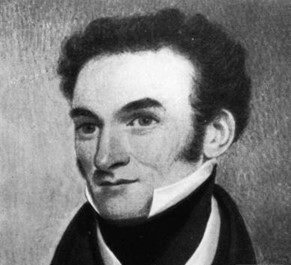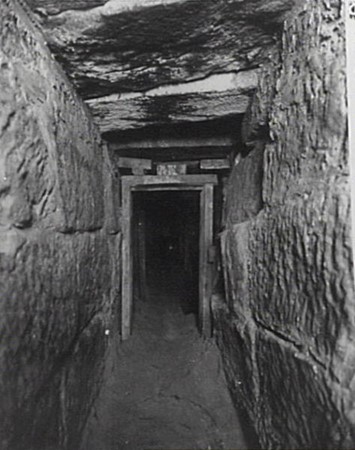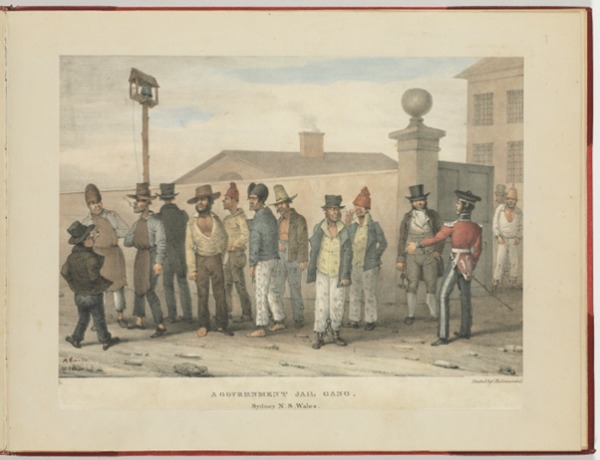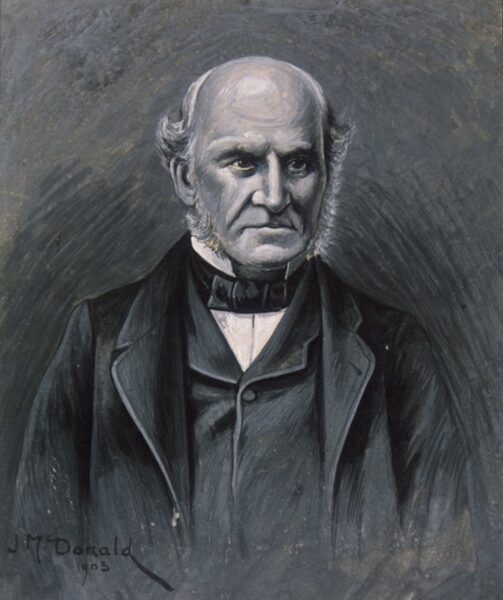John Busby – Civil Engineer born in Alnwick
24 March 1765 – 10 May 1857
A restless mineral surveyor and civil engineer, John was born in Alnwick and went on to create “Busby’s Bore”, a major landmark in the development of Australia

John as a young man
John’s father, George, was from near Rennington, and rose from being a miner to a mine manager. John left home as a young man and moved to Scotland. Without any formal training he became a mineral surveyor and civil engineer. He married Sarah Kennedy in 1798 at Haddington near Edinburgh, shortly after the birth of their first son. They had eight children: five sons and one daughter survived infancy.
The family emigrated to Australia in 1824, where John would be employed as mineral surveyor and civil engineer. After providing Sydney with a new water supply he retired to his country property near Newcastle in New South Wales, where he died in 1857. Sarah had died in 1842.
Life in Scotland
Lacking a formal education, but restless and ambitious John invented a water pump and won awards from the Royal Highland and Agricultural Society for a means of ascertaining the nature of rock strata, and a method of sinking through quicksands, clay and gravel beds.

Tools for boring into rock strata
John was employed on a variety of public work projects in Scotland, including a water-supply for the fort in Leith, the Caledonian Canal and the Botanical Gardens in Edinburgh. He also worked for a while in Ireland, and briefly returned to his home town in 1808 because he had devised a way to save the cargo from the nearby wreck of the Earl of Dalkeith, and agreed with the insurers that they would pay him 75% of anything he salvaged. It earned him £1,000, worth over £100,000 at current values.
The move to Australia
By 1821, John was in his mid-fifties. Despite his efforts the family was not as wealthy as John intended. His oldest son was close to qualifying as a doctor, and his second son had returned home after learning about wine making in France. John applied to the Colonial Office for employment in New South Wales. He produced impressive testimonials and claimed to have worked with such eminent figures as Stevenson, Telford and Rennie. The promise that he could discover vast sources of mineral wealth, prevent floods and ease droughts proved irresistible and he was appointed in March 1823 to take up duty “in the management of the Coal Mines, in supplying the Town of Sydney with water, and in objects of a similar nature”.
A voyage to Australia in the nineteenth century was expensive, long and dangerous. Life on board was uncomfortable at best, and often hazardous. In event of a disaster or shipwreck there was little hope of rescue. Few could swim, and there were rarely enough life-boats for the numbers on board. The Busby family sailed from Leith on Sept 6th 1823, in the Triton. They took their furniture, two cows, two pigs, two goats, a crate of chickens, seeds and cuttings, cases of wine and dried fruits. The eldest son, George, would follow later, after completing his medical studies in Edinburgh. Four months later they arrived at Hobart – on 19th Jan 1824. The ship stayed there for some weeks, and John made ‘a survey for water and coals’. They reached Port Jackson (Sydney) in February.

The Triton
Instead of exploring for Coal and Iron, John then went to New Zealand to refloat the government brig Elizabeth Henrietta, which had run aground (see later for details) . Others had failed, but he succeeded – presumably making use of his experience in Northumberland. For this he was paid £300.
Busby’s Bore
By now the population of Sydney was 10,800 – roughly the same as Alnwick today, but growing rapidly. New South Wales had a bad reputation – based on its past as a penal colony, but this was changing. The number of convicts arriving each year was falling, and the number of free migrants rising. As the town grew, the original water supply had become little more than an open sewer, and the growing colony was reliant on carts bringing water from swamps on the edge of town. There was a desperate need for a clean water supply – both for the town itself and for departing ships.
Busby recommended a tunnel to bring water from the swamps into town. Construction began in September 1827. This was the first engineered water supply in Australia. The scheme involved tunnelling for more than two miles (3.6 km) mostly through solid sandstone. The water was gravity fed, with a fall of 53 centimetres.

Part of Busby's Bore
The work was performed by convicts. Between 50 and 140 were employed working 24 hours a day in three eight-hour shifts. This was common practice in mining since it prevented an unnecessary build-up of underground water. Gunpowder was used occasionally, but when this occurred the tunnel filled with smoke. Most of the work was by pick through rock. The prisoners were often up to their waists in water.

A government jail gang – New South Wales, 1830.
The Bore took more than ten years to complete. It was not finished until 1837 but began supplying drinkable water in 1830. By then Busby was in his sixties.
Why did it take so long?· Busby claimed that fewer than 1/10 of the men were trained stone miners, that the rest had to be trained on the job. · He also complained of “vicious, drunken and idle habits” *and that men were often absent, preferring to work illicitly in the town. · False returns of work were made by the convict overseers. · “One third of the time lost could be ascribed to the workmen, and the villainy of the overseers”. |
|
| *Some say that Busby was not an effective supervisor: “Such was the character of the men employed, that they required constant vigilance, though such was their character that Busby was afraid ever to enter the underground workings”. | |

The Aftermath
Starting in 1844, pipes were laid, to connect houses, and a number of public fountains. In 1854, supply was supplemented by a small pumping station and in 1872, the Bore was cleaned and some irregularities removed, to increase the flow.
The creation of a municipal water supply highlighted the need for an administration to control its use and in 1842 the Sydney Corporation was formed.
After it was completed the bore was supplemented, then replaced by more advanced schemes. Busby’s Bore is now owned by Sydney Water, an agency of the Government of New South Wales. It was added to the New South Wales State Heritage Register in 1999 and listed as a National Engineering Landmark by Engineers Australia as part of its Engineering Heritage Recognition Program
James Busby-Son
When the family emigrated to Australia, John’s second son, James, was 22, and John was in his late fifties. James seems to have been instrumental in arranging the voyage, and persuading the Colonial Office to pay for the family’s passage. He was given land by the Governor of New South Wales, where he began growing grapes, and he is now regarded as the father of the Australian Wine Industry. He also became British Resident in New Zealand, representing the British Government in the early colonial settlement. Was James the real driving force behind moving the family to Australia?

James Busby in later life
Emigration
Between 1718 and 1775 over 52,000 convicts were transported from the British Isles to North America. Transported convicts made up a quarter of the British immigrants to America in the 18th century. That option ended with the American War of Independence (1775-1783), and prisons in Britain became overcrowded. Penal transportation to Australia was seen as a way to ease the problem. The First Fleet of 11 ships and about 1350 people sailed for Australia in 1787. The colony of New South Wales was established on 7 February 1788.

Neptune - a convict ship that took prisoners to Australia
When Busby and his family emigrated, penal transports were still bringing further convicts as well as free settlers to the colony. Sydney grew rapidly as free settlers arrived from Britain and Ireland and new lands were opened up for farming. At Busby’s time, around 5,355 free settlers a year were arriving in New South Wales. They were attracted by the prospect of making a new life on virtually free land. Many settlers occupied land without authority; they were known as squatters and became the basis of a powerful landowning class.
The penal transports to Sydney would end in 1840 as a result of agitation by free settlers. They continued elsewhere in Australia until 1868, and by then, approximately 165,000 people had entered Australia as convicts.
There had been discoveries of gold in Autralia from the 1820s, but the first Gold Rush started after Busby retired, following the discovery of gold in New South Wales in 1851. On the heels of a worldwide recession, the Gold Rush would transform Australia economically, politically and demographically as significant numbers of migrants were attracted from the European continent, North America and China.
His Majesty’s brig Elizabeth Henrietta
Built at Sydney, in 1816, but capsized later that year with the loss of two lives, including the Captain’s wife. Then raised, and returned to Sydney. Used to transport convict prisoners to Newcastle, but in 1823 sent to New Zealand “to promote the civilisation of the inhabitants by supplying them with British manufactures in exchange for flax”. Elizabeth Henrietta went aground after breaking adrift from the anchorage. Attempts to refloat the ship were unsuccessful, until the arrival of John Busby.
Returned to Sydney, the Elizabeth Henriatta was finally wrecked upon reefs on a voyage from Port Macquarie and Newcastle for Sydney in 1825. All the crew, passengers, convicts and military on board were rescued.

A typical brig, the Mary, a collier from South Shields, painted in 1855
With thanks to Alnwick Civic Society for their help in the material for this article.

